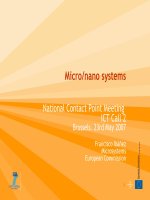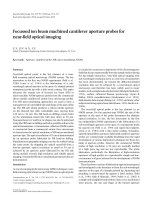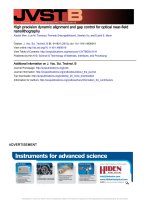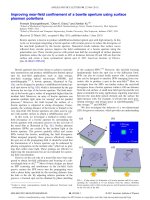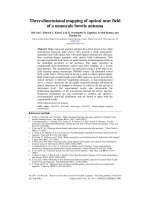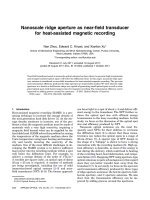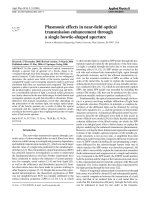Optical near field enhancement by micro nano particles for nanotechnology applications
Bạn đang xem bản rút gọn của tài liệu. Xem và tải ngay bản đầy đủ của tài liệu tại đây (8.17 MB, 150 trang )
OPTICAL NEAR-FIELD ENHANCEMENT BY
MICRO/NANO PARTICLES FOR
NANOTECHNOLOGY APPLICATIONS
ZHOU
YI
NATIONAL UNIVERSITY of SINGAPORE
2008
OPTICAL NEAR-FIELD ENHANCEMENT BY
MICRO/NANO PARTICLES FOR
NANOTECHNOLOGY APPLICATIONS
BY
ZHOU
YI
(
M.
Eng)
Huazhong University of Science & Technology, Wuhan, China
A DISSERTATION SUBMITTED IN PARTIAL FULFILMENT
OF THE REQUIREMENT FOR THE DEGREE OF
DOCTOR OF PHILOSOPHY OF ENGINEERING
NATIONAL UNIVERSITY of SINGAPORE
2008
Acknowledgements
i
Acknowledgements
At first and most importantly, I would like to express my heartfelt appreciation and
gratitude to my supervisors, Prof. Jerry Fuh, Prof. Lu Li and A/Prof. Hong Minghui for
their invaluable guidance and great support throughout every stage of my research. A/Prof.
Hong’s acute sense in most recent development trends of nanotechnology and near-field
optics science, and the patience and diligence in research work give me deep impression.
I am grateful to Prof. Boris Luk’yanchuk for his help in theoretical calculation for near-
field problems. I learned a lot from him in mathematics and optics. A special thank goes to
Dr. Wang Zengbo and Dr. Wang Haifeng for discussions and advices on theoretical
calculation. Thanks Dr. Chen Guoxin for his assistance in experiments and taking AFM
measurements. Members in Laser Laboratory, including Dr. Lin Ying, Mr. Lim Chin
Seong, Ms. Doris Ng had helpful discussions with me during the research. Other research
staffs and scholars in Data Storage Institute also shared their experience kindly during the
past years.
Lastly, I deeply appreciate my parents, my wife and son for their cares and supports.
Table of Contents
ii
Table of Contents
Acknowledgements ············································································································i
Table of Contents ··············································································································ii
Summary ························································································································vii
List of Tables ···················································································································ix
List of Figures···················································································································x
List of Symbols ·············································································································xvii
Chapter 1 Introduction ···································································································1
1.1 Introduction to near-field optics ··············································································1
1.2 Literature review·····································································································2
1.2.1 Overview of Mie theory ···················································································2
1.2.2 Extensions of Mie theory··················································································5
1.2.3 Experimental researches on Mie and its extended theory ··································8
1.3 Objectives and contributions ·················································································14
1.3.1 Objectives ······································································································14
Table of Contents
iii
1.3.2 Research contributions ···················································································15
1.4 Thesis outline········································································································ 16
Chapter 2 Near-field light scattering of small particle ················································ 18
2.1 Model and assumptions························································································· 18
2.2 The solution of Maxwell equations for non-magnetic particles······························20
2.3 The solution for magnetic particles ······································································· 27
2.4 Calculated distribution of light intensity under dielectric particles·························28
2.5 Calculated distribution of laser intensity under the metal nanoparticle··················· 31
2.5.1 Drude model for metals··················································································31
2.5.2 Light intensity distribution around metal nanoparticles···································34
Chapter 3 Experimental details ····················································································37
3.1 Sample preparation ·······························································································37
3.2 Experimental setup ·······························································································40
3.3 Light sources ········································································································ 40
3.3.1 Femtosecond laser··························································································40
Table of Contents
iv
3.3.2 KrF excimer laser···························································································41
3.3.3 Nd:YAG 532 nm / 7 ns laser ··········································································42
3.3.4 Nd: YVO
4
1064 nm / 7 ns laser ······································································42
3.3 Characterization techniques ··················································································42
Chapter 4 Near-field enhanced laser nanopatterning by silica particles ····················45
4.1 Particles array assisted nanostructuring of glass substrate by femtosecond laser
irradiation ·············································································································· 45
4.1.1 Nano-craters formed on the substrate······························································ 45
4.1.2 Light distribution under a glass particle ·························································· 48
4.1.3 Absorption during femtosecond laser irradiation ············································50
4.1.4 Influence of particle size ················································································52
4.2 Nanopatterning at different laser fluences ····························································· 60
4.2.1 Substrate morphology change with laser fluence ············································60
4.2.2 Focusing point position of spherical particle··················································· 64
4.2.3 Three-hole structure formation ·······································································66
Table of Contents
v
4.3 Nanopatterns formed with oblique light irradiation ···············································68
4.4 Femtosecond laser nanopatterning of Si through silica particle mask····················· 71
Chapter 5 Plasmonic resonance by metallic nanoparticles·········································· 74
5.1 Light scattering by Au nanoparticles ·····································································74
5.2 Jumping triangular gold nanostructures due to light absorption ····························· 77
5.3 light absorption by 40 nm spherical Au nanoparticles············································81
5.4 Light Scattering by nondissipative metallic nanoparticles near plasmon resonance
frequency···············································································································85
Chapter 6 Applications in dry laser cleaning ·······························································93
6.1 Adhesion of mesoscopic particles on the substrate ················································93
6.2 Laser cleaning of transparent particles··································································· 94
6.3 Laser cleaning of sub-50nm Au particles····························································· 102
Chapter 7 Conclusions and future work ···································································· 111
7.1 Conclusions ········································································································ 111
7.2 Future work ········································································································ 113
Table of Contents
vi
Bibliography ················································································································· 115
List of Publication········································································································· 129
Summary
vii
Summary
Near-field optics (NFO) deals with optical phenomena involving evanescent wave
which becomes significant when the sizes of the objects are in the order of wavelength or
even smaller. Since this special electromagnetic wave makes diffraction limit less
restrictive, it confines light in a volume sufficiently small for the nanotechnology
applications. The future of NFO would be seen in extensions of integrated optics towards
the nanoscale.
This thesis aims to understand several NFO fundamental issues. These problems are
related to the optical near-field induced by small particles under laser irradiation: (1)
optical resonance (Sphere Cavity Resonance) and near-field enhancement effects of
dielectric particles for laser cleaning/nanopatterning applications, and (2) plasmonic
resonance by metallic nanoparticles.
In the studies, nanopatterning beyond diffraction limit on transparent substrates was
demonstrated by 800 nm /100 fs femtosecond laser irradiation of self-assembled micro-
silica particles array. No cracks were found at edges of produced nanostructures on the
glass surface due to two-temperature non-equilibrium state. At a low laser fluence, the
nanostructure feature sizes were found from 200 to 300 nm with the average depth of 150
nm. Tri-hole structure was created when laser fluence is higher than 43.8 J/cm
2
.
Mie theory calculation shows that for 1 µm particle, the focusing point is inside the
particle which results in the explosion of microparticles and the formation of debris. While,
Summary
viii
increasing the particle size, the focusing point can be outside of microparticles.
Experimentally using 6.84 µm particles, these particles are in their integrity which verifies
that the position of focusing point depends on particle size. For most cases, the
experimental results are in good agreement with Mie theory simulation results.
Plasmonic resonance enhanced absorption of laser energy by metallic spherical
nanoparticles was discussed. Calculations of the cross section efficiencies of 40 nm Au
nanoparticles predict that at the resonance frequency, the absorption is the strongest, as
verified experimentally.
In the dry laser cleaning, field enhancement and its consequences play major roles. For
transparent particle and normal incidence, the near-field enhanced field near the centre
produces a cylindrical convergent surface acoustic wave, which benefits the particle
removal for sufficiently “big” particles (above 2 µm).
For metallic nanoparticles, the laser intensity under the particle typically diminishes, in
contrast to transparent particles, which act as a near-field lens. Nevertheless, with light
frequencies near surface plasmon resonance, the conditions for the efficient coupling of
the light with metallic surface can be provided. This plasmonic effect can help clean
metallic nanoparticles from metallic surface. The ability to clean 40 nm gold particles
from the Si substrate was experimentally demonstrated.
List of Tables
ix
List of Tables
Table 2.1 Notations for nonmagnetic and magnetic spheres 27
Table 4.1 The normalized intensity of light scattered by dielectric
spheres of refractive index n=1.25, as function of the
size parameter q.
58
List of Figures
x
List of Figures
Figure 2.1 The model of diffraction by a sphere immersed in a homogeneous,
isotropic medium.
20
Figure 2.2 Spatial Intensity distribution, I = |E|
2
, inside and outside the a = 0.5
µm glass particle, illuminated by a laser at
λ
= 800 nm, and (a)
polarization parallel and (b) perpendicular to the image plane. The
maximum intensity enhancement in calculations is about 15.7 for
both regions. (c) shows the intensity along z-axis. z = 1.0 is the
position under the particle.
30
Figure 2.3 Distribution of laser intensity within the tangential plane under the
particle with radius a = 0.5 µm, illuminated by laser at
λ
= 800 nm.
(a) 3D picture of the I = |E|
2
intensity distribution. (b) contour plot
of (a). (c) 3D picture of I = S intensity distribution and (d) contour
plot of (c). Particle is considered to be nonabsorbing with refractive
index n = 1.6.
31
Figure 2.4 Electric |E|
2
and magnetic |H|
2
fields distributions within the xz-
plane, calculated from the Mie theory for a sphere with q = 0.3 and
dielectric function
i2.02
+
−
=
ε
. Incident electric field is directed
along x-axis.
35
Figure 3.1 Self-assembly of (a) 1 µm silica particles array and (b) 40 nm Au
particles on silicon wafer
39
Figure 3.2 Schematic drawing of the laser system setup
41
Figure 3.3 Schematic drawing of tapping mode AFM
44
Figure 4.1 (a) SEM image of nano-craters formed under 1.0 µm Silica particles
on glass surface by 800 nm, 100 femtosecond single laser pulse
irradiation at a laser fluence of 35 J/cm
2
and (b) AFM image of
cross section view of craters.
47
List of Figures
xi
Figure 4.2 AFM image of a nanobump created on glass substrate with 800
nm/100 femtosecond laser irradiation. Scanning speed 400
mm/min, repetition rate 1000 Hz, laser power 10 mW, power
density 43.67 KW/cm
2
.
48
Figure 4.3
(a) Contour plot of the laser energy,
SI
=
, in x-z plane with a 1.0
µm silica particle based on the Mie theory within incident plane. (b)
3D picture of S distribution under the particle in tangential plane.
The silica particle is considered as non-absorbing materials for the
laser light with a refractive index of 1.6.
49
Figure 4.4 Distribution of laser intensity I = |E|
2
inside and outside the particle
with different particle size of (a) 2a = 100 nm, (b) 2a = 400 nm, (c)
2a = 2.0 µm nm and (d) 2a = 6.8 µm under a same laser wavelength
of 532 nm. Particle is considered to be nonabsorbing (
κ
= 0) with
refractive index n = 1.6. Background media is vacuum. Intensity is
understood as a square of the electric vector.
53
Figure 4.5 Distribution of laser intensity I = |E|
2
inside and outside the particle
with radius 2a = 1 µm for different radiation wavelength λ. Particle
is considered to be nonabsorbing (
κ
= 0) with refractive index n =
1.6 for all wavelengths. Background media is vacuum. Intensity is
understood as a square of the electric vector.
55
Figure 4.6 Variation of the optical near-field enhancement under the particle
as a function of particle size parameter. The silica particle is
considered as non-absorbing materials for the laser light with a
refractive index of 1.6.
56
Figure 4.7 The nano-craters sizes variation under glass substrate surface.
56
Figure 4.8 The FWHM size of enhancement zone with different particle sizes
on the substrate surface.
58
Figure 4.9 SEM images of the patterns formed on the glass substrate after the
laser irradiation at laser fluences of (a) 17.5 J/cm
2
, (b) 26.3 J/cm
2
,
(c) 35.0 J/cm
2
(d) 43.8 J/cm
2
, (e) 52.5 J/cm
2
and (f) 61.3 J/cm
2
.
62
List of Figures
xii
Figure 4.10 Average sizes of nano-craters as functions of laser fluence.
63
Figure 4.11 Normalized poynting intensity distribution along z axis under a
silica particle (a = 0.5 µm) by 800 nm femtosecond laser irradiation
based on Mie theory.
63
Figure 4.12 Normalized poynting intensity distribution along z axis under a
silica particle(a = 3.42 µm) by 800 nm femtosecond laser
irradiation based on Mie theory.
64
Figure 4.13 SEM image of substrate surface after femtosecond laser (100
femtosecond, 800 nm) irradiation of self-assembly 6.84 µm silica
particles.
65
Figure 4.14 Calculated enhancement in intensity distribution (z-component of
the Poynting vector),
0
IIS
z
=
, on the glass surface under a 1.0
µm Silica particles (n = 1.5 for λ = 800 nm). 3D pictures (a) and
(c) present intensity distributions, where the top of the pictures
corresponds to certain threshold for slightly different input intensity
0
I . The same distributions are also shown in contour plots (b) and
(d). The right pictures corresponds to input intensity
0
I , which is
13% higher than input intensity
0
I in the left pictures.
67
Figure 4.15 (a) Patterns on glass substrate surface under 6.84 µm glass particles
by 800 nm femtosecond laser in fluence 1.3 J/cm
2
; (b) Zoom in
image of single structure at the same sample. The incident angle is
20
0
69
Figure 4.16
2
E enhancement along x direction under glass particle with 20
0
incident angle calculated by Mie theory. Particle diameter 6.8µm,
laser wavelength 800 nm, refractive index n = 1.6, and glass
material was considered as non-absorptive.
70
Figure 4.17 Nano dents on silicon wafer surface after one pulse femtosecond
laser shoot with 2.5 mW power through 1 µm glass particle mask.
70
List of Figures
xiii
Figure 4.18 The glass surface after 2 mW femtosecond laser radiation on 1 µm
glass particles.
71
Figure 5.1 Micro-rings formed on photoresist surface after 325 nm He-Cd
laser irradiation of 40 Au particles. The insert is an AFM image of
central hole with the diameter ~ 160 nm.
75
Figure 5.2 The contour plot of intensity, |E|
2
, on photoresist surface under
aggregated 40 nm gold particles illuminated by 325 nm He-Cd laser
calculated with finite differential time domain technique
76
Figure 5.3 SEM image of triangular gold nanostructure on glass substrate as
produced by colloidal monolayer lithography
77
Figure 5.4 The jumping without melting triangular gold nanostructure on glass
after single pulse Avia 355 nm laer illumination with 17.8 mJ/cm
2
fluence.
79
Figure 5.5 The melting without jumping triangular gold nanostructure on glass
after single pulse Avia 355 nm laer illumination with 17.8 mJ/cm
2
fulence.
79
Figure 5.6 SEM image of 40 nm gold particles on Si surface after Nd:YVO
4
/ 7
ns 1064 nm laser annealing. Laser power 5.05W, repetition rate 30
KHz , scanning speed 400 mm/min
80
Figure 5.7 SEM image of 40 nm gold particles on Si surface after KrF 248 nm
single pulse laser illumination with 159 mJ pulse energy.
80
Figure 5.8 SEM image of 40 nm gold particles on Si surface after Nd:YAG / 7
ns 532 nm laser illumination. The laser fluence is 50 mJ/cm
2
.
81
Figure 5.9 Optical constant of Au in visible range 84
List of Figures
xiv
Figure 5.10 Extinction, absorption and scattering cross section efficiencies of a
a = 20 nm Au particle in air. The efficiencies were calculated with
Mie theory with the optical constants from Fig 5.9.
84
Figure 5.11
Partial polar scattering diagrams in xz -plane (
0
=
ϕ
) for the
electric dipole
1
=
l
(a), quadrupole
2
=
l
(b) and octopole
3
=
l
(c)
plasmon resonances according to Eqs. (5.12)-(5.14). Red lines
correspond to linearly polarized light, navy to nonpolarized.
90
Figure 5.12
Scattering diagram for a gold particle,
45.257.0 in +=
, in water
for radiation wavelength
λ
=
550 nm. The radius of the particle a =
8.75 nm (a), 80 nm (b) and 90 nm (c), respectively. The
corresponding size parameter 133.0/2 ==
λπ
mm
anq (a), 1.215 (b)
and 1.367 (c). Plot (d) presents a scattering diagram for a small
particle a = 8.75 nm of highly conducting material
4
10/,/4 ==
ωσωπσε
i
p
. Plot (e) represents a similar diagram
with a large value of refractive index 100=
p
n . The last picture (f)
represents details of the scattering diagram for a large particle with
q = 10 and refractive index 5.1=
p
n . Vacuum as surrounding
media, in the plots (d), (e) and (f).
90
Figure 5.13 Spectral dependencies of extinction efficiency for K cluster in KCl
matrix. Optical constants for both materials are taken from Ref. [1].
In calculations, the size effect renormalizing the collision frequency
of free electrons due to their collisions with particle surface 2,
av
F
/+→
∞
γγ
. Fermi velocity
7
106.8 ×=
F
v cm/s.
92
Figure 5.14 Scattering diagram near dipole (a, b, c) and quadrupole (d, e, f)
resonances for a potassium spherical nanocluster with radius
70
=
a
nm immersed in a KCl matrix.
92
Figure 6.1 Van der Waals Force Capillary Force Electrostatic Force
93
Figure 6.2 Van der Waals force in comparison to gravity and electrostatic
forces as a function of particle radius
.
94
Figure 6.3 The glass surface after 2 mW femtosecond laser radiation on 1 µm
glass particles.
95
List of Figures
xv
Figure 6.4 The glass particles on glass substrate after 355 nm continues wave
laser illumination with power of 0.36W.
96
Figure 6.5 Optical microscope images of before (a) and after (b) 800 nm
femtosecond laser cleaning of 1 µm glass particles on glass surface.
The scratch line in the central is for marking.
97
Figure 6.6 Normal velocity and acceleration for a line-shaped source (a) and
for point source at different distances (b).
99
Figure 6.7 Normal velocity (a) and acceleration (b) for a ring-shaped source
with radius
a
= 7 µm and width
r
δ
= 0.2 µm. Dot lines present the
acoustic wave which came from the region of homogeneous
heating. For this case
µm42
=
a
and
µm41=
r
δ
. Total energy is the
same as that in Fig. 6.6.
101
Figure 6.8 Maximal surface temperature at threshold fluences, calculated for
excimer laser 248 nm, with pulse duration 23 ns. Removal of SiO
2
particles on Si, Ge and NiP substrates was investigated. Three
curves in the pictures are calculated with different approximations.
1D curves present results of one-dimensional theory [132], which
neglects variation of the intensity under the particle; Mie-curves
show the result of calculations for the case, when near-field
focusing effect is taken under the approximation of the Mie theory;
POS-curves calculated on the basis of “particle on surface” theory,
which takes into account the secondary scattering of radiation
reflected from the surface of substrate.
103
Figure 6.9 The extinction, scattering and absorption cross-sections for a gold
particle of 20 nm radius sphere as a function of laser wavelength
λ
(a). The distributions of field
2
E around the Au particle at an exact
dipole resonance with
λ
= 498 nm (b).
105
Figure 6.10 Contour plots for intensity distribution in xz-plane (a, c) and
normalized intensity (z-component of the Poynting vector) under
the 40-nm gold particle on n-Si surface (b, d) at different incidence
angles:
α
= 0
o
(a, b) and
α
= 45
o
(c, d).
107
List of Figures
xvi
Figure 6.11 SEM images of 40 nm gold nanoparticles on the n-Si substrate
surface before (a) and after (b) 300 pulses (532 nm, 7 ns) at a laser
fluence of 50 mJ/cm
2
and an incidence angle of 45
o
.
108
Figure 6.12 Cleaning efficiency as a function of incidence angle. 110
List of Symbols
xvii
List of Symbols
E
Electric field k Wave vector
e
D Electrical Debye potential
H
Magnetic field
ω
Angular frequency
h
D Magnetic Debye potential
m
ε
Dielectric permittivity of medium
p
ω
Plasma frequency
m
µ
Magnetic permeability of medium
p
ε
Dielectric permittivity of particle
λ
Laser wavelength
p
µ
Magnetic permeability of particle
S
Ponyting vector
q
Size parameter
κ
Absorptive index; heat conductivity
n
Reflective index
I Laser intensity
a
Radius of particle
sca
Q
Scattering coefficient S
0
Enhancement factor at particle-
substrate contacting point.
ρ
density; electron density
ext
Q
Extinction coefficient
T temperature
abs
Q
Absorption coefficient
α
Incidence angle; absorption
coefficient
c Heat capacity; light speed
τ
electron relaxation time t time
0
γ
electron relaxation rate
e
m
free-electron mass
0
I
input laser intensity
A
particle geometrical cross section
'
ε
real part of permittivity
"
ε
image part of permittivity
F
ν
Fermi velocity
p
pressure
Rlt
C
,,
propagation velocity of transverse,
longitudinal and Rayleigh waves
Chapter 1 Introduction
1
Chapter 1 Introduction
1.1 Introduction to near-field optics
In general, a near-field is referred to a region with distance in micro/nano scales. Near-
field optics (NFO) deals with phenomena involving evanescent electromagnetic waves.
This special electromagnetic wave becomes significant when the size of an object is in the
order of incident wavelength or even smaller [3], where so-called Mie resonance or
morphological resonance become important [4]. Nowadays, theory of electromagnetic
waves describes satisfactorily their interactions with objects which are macroscopic
relative to the incident wavelength. However, the theoretical knowledge about the
scattering of electromagnetic waves by micro/nano-systems remains limited. Most
approximations are not appropriate to study micro/nano-systems. These systems require
the detail solutions of the full set of Maxwell equations. The main origin of these
problems can be back to the crucial role played by the evanescent components of the field
in the near-field zone close to micro/nano-particles.
According to Diao et al. [5], the optical scattering of a small particle can be classified
into two categories: (1) sphere cavity resonance (SCR) in a dielectric particle and (2)
plasmon resonance (PR) in a metal particle. Plasmons are defined as electromagnetic
excitations coupled to the free charges of a conductive medium. In modeling, both SCR
and PR can be satisfactorily described by Mie theory [6], which is an exact solution of
Maxwell equations for an arbitrary sphere under the plane wave excitation.
Chapter 1 Introduction
2
Theoretically, the SCR resonance is very sharp. It means that the optical resonance
produces high intensities in the near-field region and, naturally, it can lead to the
formation of “hot points”. Clearly, these “hot points” influence the laser cleaning
efficiency and are responsible for surface nanostructuring applications as well.
Meanwhile, it is well known that a small metal particle, such as gold and silver
nanoparticles, under direct laser irradiation can excite localized plasmonic effect [7],
which is collective oscillations of free electrons confined inside the particles. These are
two possible reasons why plasmonics is hot in recent years: (1) People cannot completely
understand all the aspects of plasmonic effect. In other words, a large amount of unknown
issues exist in the field, and (2) the promising applications in nanopatterning which can
improve data storage density and in nanostructure characterization which can achieve the
observation under molecular range.
1.2 Literature review
1.2.1 Overview of Mie theory
In a paper published in 1908, G Mie [6] obtained, on the basis of the electromagnetic
theory, a rigorous solution for the diffraction of a plane monochromatic wave by a
homogeneous sphere of any diameter and of any composition situated in a homogeneous
medium. Mie theory is a separation of variables approach which gives an analytical
equation for the Mie coefficients. The interesting early history of light scattering was
Chapter 1 Introduction
3
reviewed by Logan [8].
The optical scattering of a small particle can be classified into two categories: (1)
sphere cavity resonance (SCR) in a dielectric particle and (2) plasmon resonance (PR) in a
metal particle [5]. It is known for more than 50 years that the optical resonance is
responsible to the ripple structure of the extinction [9]. The first analysis of the optical
resonance was carried out with respect to conventional applications in colloid and aerosol
physics. The new interest to optical resonance arises due to the studies of resonance
phenomena in radiation pressure [10], optical levitation [11] and long-wave optical
spectrum in ionic crystals. Traditionally, optical resonance is inspected in the far field by
spectroscopic techniques, e.g. absorption/extinction spectra measurement [12], in which
the electromagnetic field is dominated by the propagating mode. On the contrary, the
peculiarities of the laser cleaning/nanopatterning problems are related to the near-field
region where the evanescent wave is dominant instead of propagating wave [13, 14].
In sphere cavity resonance (SCR), the incident field excites resonance but undamped
modes in dielectric spheres are distributed as evanescent waves around the sphere. In the
near-field region of the sphere cavity, the field distribution is dominant with these
evanescent waves, and is sensitive to the size parameter of the sphere. The SCR
resonances are very sharp, and the efficient divergence of radiation for corresponding
modes is very small. It means that optical resonance produces high intensities in the near-
field region and, naturally, it can lead to the formation of “hot points”. In contrast to SCR,
PR mode in a metal sphere is generated due to the oscillation of free electrons inside.
Chapter 1 Introduction
4
These PR modes are damping modes due to the high dissipative factor of metals.
Both SCR and PR can be satisfactorily described by Mie theory in modeling. The
geometrical optics (for big particle with
λ
>>
a
) and dipole approximation (for small
particle with
λ
<<
a
) can be regarded as the two limiting cases of Mie theory. In near-
field optics (NFO) where micrometer size particles are concerned, the simulation by
dipole approximation could lead to inaccurate results due to the excitation of higher-order
multipole resonance modes in particles. It needs detail theoretical analyses with sufficient
number of mode terms. The inclusion of a small term in Mie series beyond dipole
approximation could significantly distort the phase portrait of optical near field and
produce a completely different near-field distribution.
The solution due to Mie theory, though derived for diffraction by a single sphere, also
applies to diffraction by any number of spheres, provided that they are all of the same
diameter and composition and provided also that they are randomly distributed and
separated from each other at a distance that is large compared to the wavelength. Under
these circumstances, there are no coherent phase relationships among the lights scattered
by different spheres. The total scattered energy equals to the energy scattered by one
sphere multiplying the total number of spheres. It is particularly in the connection that Mie
solution is of great practical value and may be applied to a variety of problems: in addition
to the question of colors exhibited by metallic suspensions. We may mention applications,
such as the study of atmospheric dust [15], interstellar particles or colloidal suspensions
[16], the theory of the rainbow, the solar corona, the effects of clouds and fogs on the
Chapter 1 Introduction
5
transmission of light [17].
Although the light scattering and absorption by a spherical particle (with any size and
optical dielectric constant) were solved in 1908 by Mie, this theory (together with many of
its extended theories) still remains its invaluable contributions today, especially in the
NFO. In micro/nano-regions, most research interests in NFO could be approximately
modeled by small particles, such as colloid, sharp tip, single molecule and bio-virus. The
near field enhancement around such sub-micron particles is of immediate relevance to
near-field optics microscopes [18] or, to some extent, pointed tips [19]. In the near field,
for sufficiently small particles, only the lowest order solution, equivalent to dipole
excitation, is of significance. The scattering efficiency is proportional to
)2/()(
mpmp
εεεε
+−
in this case, where
mp
εε
,
are the dielectric constants of the particle
and the surrounding medium, respectively.
1.2.2 Extensions of Mie theory
As Mie theory is restricted to spherical homogeneous spheres, there are many
extensions of this theory covering different aspects. Some relevant aspects will be
described in the following.
Shortly after Mie, P. Debye [20] published a paper concerned with light pressure
induced by irradiation of particles, i.e. the mechanical force exerted by light, on a
conducting sphere, the subject has been treated in different aspects by many researchers
[21,22]. The plasmon resonance based optical trapping method is used to achieve stable
Chapter 1 Introduction
6
trapping of metallic nanoparticles. In all cases, the longitudinal plasmon mode of these
anisotropic particles is used to enhance the gradient force of an optical trap, thereby
increasing the strength of the trap potential [23]. While for this plasmonic effect, it can be
readily extended from the Mie scattering theory. For small particles, the divergence in
scattering efficiency at
02 =+
mp
εε
is the condition for the lowest order plasmonic
resonance. Upon approach if a third medium,
m
ε
becomes a weighted average of the
dielectric constants of the second and the third medium. This modifies the resonance
conditions, as a function of distance between the particle and the third medium [24]. An
advanced algorithm was given by Toon and Ackerman [25]. An algorithm for a sphere
with two coatings was given by Kaiser [26]. This has been used to compute the internal
field of a particle at resonance. Such algorithms may help in identifying water droplets
collecting dust or soot on the outer surface [27].
The electromagnetic Green’s tensor approach is used to obtain the differential and total
scattering cross sections of a finite size nanoparticle located at a metal surface [28]. The
scattering process comprehends either elastic scattering of the incident surface plasmon
into other surface plasmon propagating in different directions or scattering into field
components propagating away from the surface, as well as the irradiation absorption by
the meal nanoparticle. A scattering theory for magnetic spheres can easily be formulated
[29]. This may be relevant for scattering at infra-red or microwave frequencies. The
scattering theory of coated dielectric spheres was first derived by Aden and Kerker [29].
The scattering of light by particles of shapes other than spheres has been considered by
